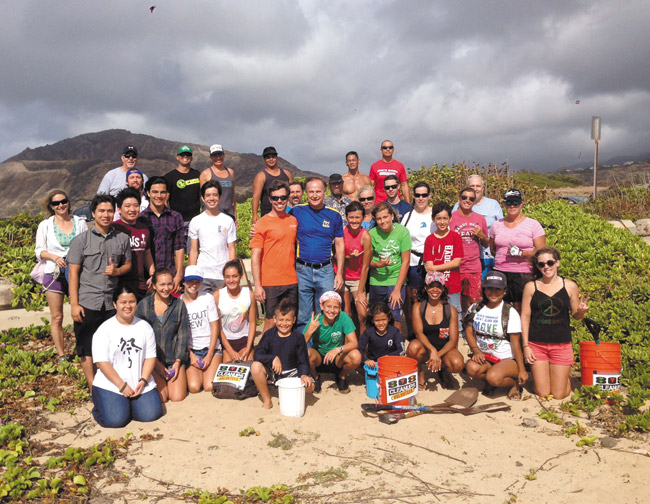Keeping It Clean And Pristine

State Rep. Gene Ward (center, blue shirt), Michael David Loftin (orange shirt) of 808 Clean Ups and dozens of volunteers celebrate Earth Day with a workday PHOTO COURTESY REP. GENE WARD
Imagine a child having the time of his life, running wild on a white sandy beach, but then suddenly falling to his knees in excruciating pain.
Now imagine the source of that pain: a rusty old nail.
Never mind imagining. Sadly, it is a scenario that’s happened before along scenic Ka Iwi coastline in East Honolulu.
“Too many people are leaving their trash behind and wreaking havoc on what is otherwise a beautiful stretch of coastline,” says state Rep. Gene Ward of Hawaii Kai. “And many people are leaving behind dangerous trash. Some people are burning big pallets and leaving behind the nails from those pallets on the sand. I’ve heard many horror stories of young kids stepping on nails, and that’s unacceptable!”
It’s one of many reasons that Ward has hosted an annual beach cleanup near Alan Davis Beach. This year marked the seventh community-based event.
“Every year, in celebration of Earth Day, my office organizes a beach cleanup,” explains Ward. “This year we had more than 50 people combing the sand and cleaning the area of nails, plywood, pallets and broken beer bottles. We had a great turnout!”
In addition to Boy Scouts from Troop 101, Ward says volunteers from the Peace Corps, Kaiser High School and constituents from his district took part in the daylong event.
“We had a new group that joined us this year called 808 Clean Ups,” says an excited Ward. “The man leading that group (Michael David Loftin) is doing a great job making a difference and partnering with communities. I wish we could have a cleanup like this once a month!”
Gloves and trash bags were provided. Volunteers were encouraged to bring their own magnets to pick up nails that often are hidden in the sand. The final numbers are mind-boggling.
“This year we collected 432 pounds of rusty nails, burned crates and wood, glass bottles and plastic,” says Ward. “Yes, there’s a lot of stuff being left out there! Hopefully, we left the beach so clean that the next party that goes to the beach will think twice about what they’re doing and clean up after themselves.”
Clearly this is a “local” problem, not a tourist problem.
The battle to keep Ka Iwi coastline free of development has gone on for decades. There have been numerous ideas introduced through the years, including proposals to build hotels and resort-style cabins overlooking the ocean. There even was a plan to create a golf academy on the precious land.
None has come to fruition. The good fight has been won — so far — but the battle to keep the area free of garbage and dangerous debris continues.
Ward says the state Department of Land and Natural Resources doesn’t have the staff or officers to constantly monitor this area and enforce laws that are in place, so it is imperative that the community does its part.
“As we progress and continue to keep the Ka Iwi coastline undeveloped and the land mauka pristine, there is still one glaring issue that we have not properly addressed — and that’s trash that we’re leaving behind,” says a concerned Ward.
“It is one of the last pristine areas on Oahu, and we have to take care of it. We need to make sure that this coastline stays the way it is with no housing and no development. It’s about preservation, but it’s also about beautification.”
And it’s also about keeping the area safe and clean for our keiki and the next generation. No one should have to worry about stepping on an old rusty nail.
Rep. Ward is right. That’s unacceptable, and that’s something we can control.
rkmizutani@gmail.com





